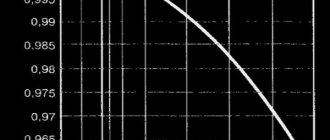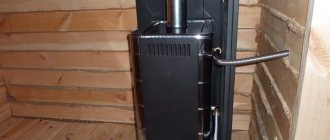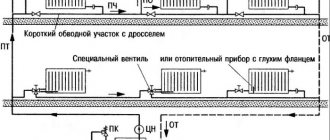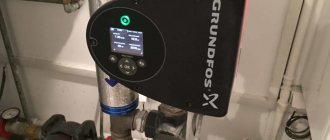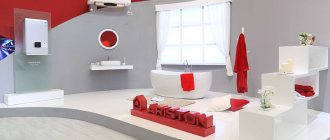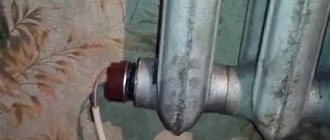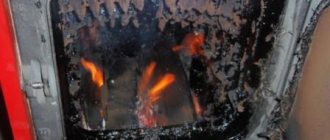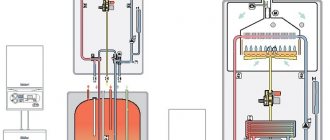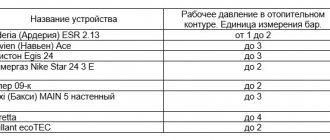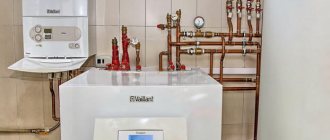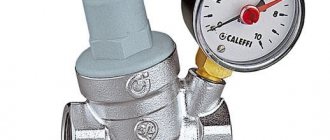For what purposes is steam needed?
Knowing where a steam boiler is used and with what modes allows you to effectively select equipment.
PCs are used in the following industries:
- Housing and communal services in central heating install PC modifications of low or medium pressure for steam heating. The coolant enters either directly into the network, or through heat exchangers it prepares water for central heating and hot water supply.
- The industry uses more powerful steam generators that produce superheated steam with increased heat transfer.
- Energy, high pressure steam boilers are involved in electricity generation schemes by transferring steam to a turbine.
- Industry, PCs provide mechanical movement of production devices.
- Railway transport, PCs are installed on diesel locomotives.
Operating principle of a steam boiler
For the operation of high-pressure steam boilers, chemically treated water is used, heated through packages of screen pipes, under the influence of hot flue gases formed as a product from the combustion of natural fuel.
As the temperature rises, the water is converted into steam, which enters the application area to transfer thermal energy or kinetic energy of the jet.
Schematic design of the boiler for steam production
Principle of operation:
- Natural water is supplied to water treatment, where it is purified from suspended solids and softened. It is then supplied in tanks of chemically purified water and fed into the unit using feed pumps for steam devices.
- Before entering the drum, the nutrient medium enters through an economizer - a cast-iron heat-heating device located at the rear of the unit to reduce the temperature of the flue gases and increase the efficiency of the steam boiler.
- From the upper drum, water flows through unheated pipes into the lower drum, and rises from it through rising convective pipes in the form of a steam-water mixture.
- The process of separating it from moisture takes place in the upper drum.
- Dry steam is sent to consumers through steam lines.
- If it is a steam generator, then the steam is reheated in the superheater.
Drum boilers
Water circulation in a forced circulation drum boiler1 Feed pump 2 Economizer 3 Rising pipes 4 Falling pipes 5 Drum 6 Superheater 7 To turbine 8 Circulation pump
Water supplied to the boiler by a feed pump (for example, a steam injector), after passing through the economizer, enters the drum (located at the top of the boiler), from which, under the influence of gravity (in boilers with natural circulation), it enters the lowering unheated pipes, and then into the rising heated ones where steam formation occurs (rising and falling pipes form a circulation circuit). Due to the fact that the density of the steam-water mixture in the screen pipes is less than the density of water in the downcomers, the steam-water mixture rises through the screen pipes into the drum. It separates the steam-water mixture into steam and water. The water goes back into the downpipes, and the saturated steam goes into the superheater. In boilers with natural circulation, the frequency of water circulation through the circulation circuit is from 5 to 30 times. Boilers with forced circulation are equipped with a pump that creates pressure in the circulation circuit. The circulation rate is 3-10 times. Boilers with forced circulation have not become widespread in the post-Soviet space. Drum boilers operate at a pressure less than critical.
Steam boiler structure
The design of a PC can be simplified in the form of a container where water is converted into steam. It is made of pipes of different diameters. In addition to the pipe system, the PC has a combustion chamber in which natural fuel is burned.
The design of a steam boiler and its design features are determined by the type of fuel. For example, coal fireboxes are equipped with grates on which a burning fuel layer is placed, through which oxygen enters the firebox.
A chimney is installed at the top of the firebox, which creates draft in the steam-gas path of the unit, thereby maintaining normal operation. Gas-fired steam boilers have gas or oil burners.
I heat the hot exhaust gases produced during the combustion of fuel to boiling water, after which steam begins to be released from the evaporation surface and supplied to the consumer, and the flue gases escape through the pipe into the atmosphere.
The main structural elements of steam boiler houses are connected into one complete boiler system using fittings, fittings, circulation pumps, instrumentation and control of smoke exhausters and fans.
Device
A strong hot stream of steam is capable of moving objects that are in its path. This ability is used in the operation of a steam boiler. The first very simple steam boiler was built by the Englishman Thomas Savery in 1698. A fire was lit in the firebox, which heated the water in the tank above it. Of course, it produced very little steam, it actually flew into the chimney, the fuel was burned in vain.
According to the Great Soviet Encyclopedia, “A steam boiler is a device that has a furnace, heated by gaseous products of organic fuel burned in the furnace and designed to produce steam with a pressure higher than atmospheric, used outside the device itself. The working fluid of the vast majority of steam boilers is water.” Simply put, a modern steam boiler is a closed unit that has a firebox in which combustion products heat water, turning it into steam. Steam under high pressure travels further through the pipes, i.e. the evaporation process creates conditions for natural circulation.
Steam boilers are divided into gas-tube and water-tube. In gas-tube boilers, hot gases passing through pipes give off their energy and heat to the water that washes these pipes. And in water-tube boilers, steam and water under high pressure are simultaneously located in a small-diameter pipe. But this is precisely what makes water tube boilers safe to use, because... the possibility of an explosion is reduced. Although water-tube steam boilers are more complex than gas-tube boilers in design, they heat up quickly, are easy to transport, and can be overloaded, although the units and components included in its design should not allow leaks at high temperatures and pressures. The most important thing in a steam boiler is the firebox. For its operation, solid fuel (coal or firewood) and mobile fuel (coal dust, fuel gas or fuel oil), as well as electricity, are used. In order for fuel to burn, draft is necessary - a pressure difference that forces air, and with it the flue gases, to pass through the firebox. Natural draft is created by a chimney, usually a tall one, and forced draft is created by pumps.
Steam boiler diagram
Coolant flow diagram
PCs are installed in the boiler room, which can be located in separate, adjacent and built-in non-residential buildings.
Designations according to the diagram:
- Gas steam boiler fuel supply system, No.1.
- Combustion device - firebox, No2.
- Circulation pipes, No.3.
- Zone of steam-water mixture, evaporation mirror, No.4.
- Direction of feed water movement, NoNo5,6 and 7.
- Partitions, No8.
- Gas flue, No.9.
- Chimney, No.10.
- Output of circulating water from the steam boiler tank, No.11.
- Purge water drain, No.12.
- Boiler top-up with water, No.13.
- Steam manifold, No14.
- Steam separation in the drum, NoNo15,16.
- Water indicator glasses, No17.
- Saturated steam zone, No.18.
- Steam-water mixture zone, No.19.
Types of steam boilers
PCs are classified according to several parameters and you need to know them, because how the steam boiler works depends on it.
By type of fuel burned:
- gaseous fuel;
- solid fuel steam boilers;
- liquid fuels: fuel oil, diesel fuel;
- Electric Energy.
By purpose:
- Waste heat boiler - participates in schemes for saving fuel and processing secondary heat emitted during the production process or from flue gases at thermal power plants.
- Energy - steam boiler houses are involved in the electricity generation scheme as a source of steam for turbines; they operate with high flow rates and steam parameters.
- Heating units for central heating and hot water supply, which are subject to the rules for the design and safe operation of steam and hot water boilers.
- Industrial - participate in the production processes of the enterprise.
Classification of steam boilers by firebox design:
- Chamber - use pulverized fuel.
- Bed solid fuel – burning solid fuel.
Water tube
The operation of water tube boilers (WTB) is characterized by the fact that the main coolant - feed water - passes through the screens, and flue gases through the inter-tube space. Reaching the boiling point, water turns into steam.
The efficiency of steam generation depends on the design of the screen pipes and the type of feedwater circulation; these indicators are taken into account before calculating the power. The most used VK schemes are drum and direct-flow. The first type of steam boiler is designed horizontally or vertically.
A typical drum boiler design is a firebox limited by pipe screens, the packages of which are connected at the bottom by manifolds, and the top is fixed in the upper drum. The second bundle of boiler pipes connects both VK drums into one circuit operating in a zone of lower temperatures.
The heat from fuel combustion is transferred through the pipe system to water by convection and radiation; the steam-water mixture enters the upper drum, where steam is separated from moisture.
Released water into the lower drum and combustion headers. The circulation speed of the internal circuit of the VC depends on its type. The most popular boilers on the Russian market are those with natural circulation.
The production of steam boilers is carried out at the Biysk Boiler Plant: DKVR-2.5; 4; 6.5; 10; 20.
Fire tube
Gas-tube or fire-tube boilers are VK “in reverse”, that is, water moves through the inter-tube space, and the exhaust gases are in one or more pipes. These low power steam boilers remain in use from the pre-war period of the 19th century.
Steam production process:
- The firebox is located directly in the tube part of the boiler, where combustion of the fuel mixture occurs and the formation of flue gases.
- These devices are manufactured with flame or smoke tubes.
- In the first, the combustion process occurs directly in the pipe, for which a gas-oil burner with a fan is installed at the inlet, promoting uniform combustion along the length of the firebox.
- In smoke stacks, fuel is not directly burned, but water is heated by heated flue gases.
For these boilers with a steam pressure below 0.7 MPa, the rules for the design and safe operation of steam and hot water boilers do not apply. Boiler water moves through the inter-tube space and, when heated, turns into steam; the process is completed in the upper part of the boiler and, with the help of a bypass valve, the steam passes into the main line.
Diesel boilers have a limit on the outlet temperature of flue gases of up to 150 C. This requirement is caused by the need to technologically ensure draft in chimneys. This fact reduces the power of boilers - about 400 kW, with steam pressure up to 10 kgf/cm2.
Cast iron sectional
Boilers with cast iron packages or sections are widely used in heating and hot water networks. The design of such units has advantages due to the possibility of quick assembly or dismantling, as well as a simple increase in boiler power by adding sections.
The operation of steam boilers with a successful design has a significant drawback: if one package breaks, all sections of the unit will have to be dismantled.
Boiler owners do not require permits, since they are not subject to the rules for the design and safe operation of steam and hot water boilers.
These boilers are efficient and heat up quickly, since the combustion chamber is formed directly by the internal surfaces of the sections.
The units resist corrosion processes well in the aggressive environment of flue gases and have increased thermal conductivity, but are not capable of operating at high steam parameters, maximum pressure values are less than 100 kPa, power values are not more than 200 kW, steam output is up to 4.3 t/hour, consumption solid fuel - 300 kg/hour.
Direct flow
Direct-flow steam units belong to vertical steam boilers and are designed so that the water in the screen pipes is forced to complete only one cycle and at the same time completely transform into a vapor state, therefore, in these types of steam generators, the circulation ratio is 1.
Such boilers are much simpler in design and do not require complex automation of the combustion process. They are non-volatile and cannot do without a feed pump, therefore they are much more explosive than circulation boilers, despite the fact that their thermal efficiency and steam production are low.
Once-through installation
In a once-through unit, the movement of water occurs due to gravitational convection, since water is heavier than steam. Recently, for devices that have reached their standard service life, steam boilers have been switched to hot water mode to reduce the load.
Features of a single-turn PC:
- The firebox is made of pipes that are heated by flue gases.
- Boiler water enters the lower part of the water heating circuit, and dry steam is taken from the opposite upper part.
- In the economizer, the incoming coolant is heated to saturation temperature, and in the screen pipes and superheating circuit, the steam parameters further increase to the design values.
- These surfaces do not have a clear separation from each other, and their geometry depends on the design load of the unit. With a decrease in the temperature of the flue gases and an increase in the speed of the boiler water, the boundaries of the economizer and evaporator shift, and the length increases accordingly and vice versa.
- Steam production is limited by the increase in hydraulic resistance and cannot be more than 10 t/h. For more powerful boilers, multi-turn unit designs are required.
Steam BMK
Block-modular boiler house (BMK) manufactured in the form of a compact module with a full set of auxiliary equipment.
It is intended for heating and hot water supply, as well as generating steam for the technological needs of enterprises located in areas with energy shortages. The BMK does not require the constant participation of an operational person, and in the event of an emergency, protection with an alarm is triggered.
The operation of the unit is fully automated: sensors monitor the internal temperature of the room, the data is transmitted to the control panel, where the operation of the BMK is adjusted.
The unit can be quickly connected to an existing heating system as an independent emergency source of thermal energy.
Transportation to the installation site of the BMK is carried out in full factory readiness and with a chimney; on site it is only connected to existing utility networks. This factory assembly minimizes installation and adjustment work and increases the efficiency of the installation to 93%.
Analysis of thermal processes in a steam boiler with natural circulation
A steam boiler (steam generator, boiler unit) is a unit in which, due to the thermal energy generated during fuel combustion, feed water is converted into steam with a pressure above atmospheric. According to the principle of operation, the boiler is a complex heat exchange apparatus in which physical phenomena associated with the processes of heat exchange and circulation of water, steam and steam-water mixture occur.
The essence of the heat exchange process is that heat from a high-temperature medium (hot gases) is transferred to a low-temperature medium (boiler water, steam and air). Heat exchange in boilers occurs through the walls of pipes and chambers, which are heating surfaces, and is carried out in three ways: thermal radiation, convection and thermal conductivity. The combined action of these three methods of heat transfer is called heat transfer. Heat propagation in water and steam occurs mainly by convection.
First, the water is heated in an economizer; in a boiling-type economizer, it is partially evaporated. Then intensive steam formation occurs in the combustion chamber; due to the difference in densities, the steam-water mixture rises into the drum, where it is separated into steam and water. The steam is overheated, and the water returns through the downpipes to the combustion space, where a steam-water mixture is again formed.
Particles of liquid (steam) that are in direct contact with heating surfaces receive heat from them, heat up, become lighter and rise upward, giving up part of their heat and giving way to neighboring, colder, and therefore heavier particles. As a result, the movement of liquid particles occurs in the form of ascending and descending flows and heat exchange occurs within the mass of liquid (water and steam). This phenomenon of continuous movement of water and steam particles is called natural circulation.
The heat generated by the furnace of a steam boiler during fuel combustion is transferred to water and water vapor in the heating surfaces. Thus, two media are involved in the heat exchange process: heat transferring (heating) and heat receiving (heating).
The main heat transfer medium (or coolant) in steam boilers is the combustion products (flue gases) generated in the furnace. In recovery boilers, the coolant is hot gases generated during the working process of diesel or gas turbine engines.
The heat-receiving medium in steam boilers can be: water and steam-water mixture - in the evaporative heating surfaces; — water vapor — in steam superheaters; — water — in the economizer; — air — in the air heater.
During the working process occurring in steam boilers, all three types of heat exchange take place:
− radiant (radiation) heat exchange - occurs mainly in the furnaces of steam boilers and partially in other heating surfaces;
− convective heat exchange - occurs when hot gases wash convective heating surfaces;
− thermal conductivity - with the help of this type of heat exchange, heat from the coolant is transferred through the walls of the pipes to the heated medium.
There are three types of heating surfaces in boilers:
− evaporative;
− steam superheaters;
− economizer.
Heat exchange occurs in them in different ways: in evaporative heating surfaces due to radiation (radiation), in steam superheating surfaces - by radiation and convection, in economizer surfaces - by convection.
The steam-generating surfaces of boilers are located mainly in the combustion chamber. In medium-pressure drum boilers, economizers are of the boiling type, since the feed water is heated not only to the saturation temperature, but is also partially converted into steam. In high-pressure drum boilers, the proportion of heat used for steam generation is lower than in medium-sized ones, so the heat supplied to the screen pipes, where the required amount of steam is obtained, is sufficient, which is why economizers are non-boiling.
At high and supercritical pressures, steam superheater surfaces consume a significant portion of heat absorption and cannot be placed only in a horizontal gas duct, because part of the surface of the steam superheater occupies the top of the furnace (ceiling, wall panels), and the outlet convective package is often located in the upper part of the convective shaft.
The heat absorption of the economizer and air heater is 30-35% of the total heat absorption of heating surfaces, steam superheating surfaces - 20-22%, combustion screens (evaporation surfaces) - 35-50%.
Combustion screens are located in the zone of the highest gas temperatures; they are made in the form of vertical panels that completely cover all the walls of the furnace and have only a lifting movement of the working medium. The design of the screens must ensure continuous heat removal to prevent burnout of tubes, disruption of hydraulic conditions and avoid emergency situations.
The transfer of heat to the combustion chamber screens is determined mainly by radiant heat exchange between high-temperature gases filling the combustion volume and the outer surface of the pipes covered with a layer of contaminants. In open combustion chambers with a lifting movement of the torch due to convection, the heat absorption of the combustion screens can be neglected, since the velocities of the gases near the walls of the furnace are low, and external contaminants create a large thermal resistance. In furnaces with vortex movement of the torch (cyclone pre-furnaces, furnaces with intersecting jets), the convective component of heat transfer becomes noticeable and must be taken into account.
One of the important features of the heat exchange process in the furnace is that it occurs simultaneously with the combustion of fuel.
The superheater superheats saturated steam to a predetermined temperature. It is one of the most critical elements of the boiler, since the steam temperature here reaches the highest values and the metal operates under conditions close to the maximum permissible. Typically, smooth pipes are used for steam superheaters, but their specific heat absorption is limited. To intensify heat exchange in superheaters, fin tubes and transverse and internal longitudinal fins are used.
Depending on the location of the superheater in the boiler and, consequently, on the type of heat exchange taking place in it, radiation, screen (semi-radiation) and convective superheaters are distinguished.
Radiation superheaters are placed on the ceiling of the combustion chamber or on its walls, often between screen pipes. These superheaters, like evaporation screens, perceive the heat emitted by the combustion fuel torch. Screen steam superheaters, made in the form of separate flat screens from parallel-connected pipes, are mounted at the outlet of the furnace in front of the convective part of the boiler. Heat exchange in screen steam superheaters is carried out both by radiation and convection. Convective superheaters are located in the flue of the boiler unit, usually behind screens or behind the firebox; they are multi-row packages of coils. Superheaters consisting only of convective stages are usually installed in medium and low pressure boilers at a superheated steam temperature of no higher than 440–510 °C. In high-pressure boilers with significant steam superheating, combined superheaters are used, including convective, screen, and sometimes radiation parts. Boilers of thermal power plants must be equipped with a superheater, since increasing the temperature of the steam increases the thermal efficiency. steam power plant. At a steam pressure of 14 Mn/m2 (140 kgf/cm2) and higher, usually, in addition to the main (primary) superheaters, secondary (intermediate) superheaters are installed, in which the steam partially exhausted in the turbine is superheated.
The economizer and air heater use the temperature of low-temperature combustion products (400–1200C) and are placed in a convective shaft. When designing these heating surfaces, the main task is to intensify heat transfer and create elements with less metal consumption that would not be subject to severe ash wear and corrosion damage. The air heater has the lowest heat transfer coefficient, because its heating surface exceeds the total heating surface of all elements of the water-steam path and can reach tens and hundreds of thousands of square meters. With a single-stage heater arrangement, the air is heated to 250–3000C; if it is necessary to heat the air to a higher temperature (350–4500C), the air heater is made in two stages, placing part of the economizer between its two stages (in a cut).
To intensify heat exchange in the economizer, the economizer coils are made of small-diameter pipes (28–32 mm with a wall thickness of 2.5–3.5 mm) and equipped with fins. The fin tube has a large specific heating surface and increased heat absorption. The movement of water in the economizer is upward, which ensures free exit with water of gases released during heating and in boiling economizers of steam.
Literature:
- Reznikov M.I., Lipov Yu.M. Boiler installations of power plants, 3rd ed., Moscow: Energoatomizdat, 1987–288 p.
Steam boiler wiring diagram
Strapping diagram. Photo source: strangely.ru
A typical PC piping scheme depends on the type of steam generator and its operating parameters.
For central heating systems of the housing and communal services system, the typical scheme consists of:
- Steam generator.
- Deaerator.
- Softener according to the chemical cleaning scheme.
- Dispenser and reagent tank.
- Receiver.
- Pressure regulators.
- Boiler feed water pump.
- Pump for supplying water from the deaerator to the receiver.
The boiler design may also include:
- superheater - to increase the temperature of saturated steam;
- steam separator and intra-drum devices - to remove moisture from steam.
How to use it correctly
Steam boilers are classified as high-risk objects, therefore, many boiler inspection regulations, installation designs, technical documentation of the manufacturer and rules for the design and safe operation of steam and hot water boilers set out requirements for the safe operation of such vessels, which are required to be followed by responsible officials and maintenance personnel.
Safe operation begins with chemical water treatment, which is essential for the maintenance of modern steam generators and boilers. Mineral salts contained in natural water, at temperatures above 70 ° C, form scale on the internal surfaces of pipes.
This leads to a deterioration in heat transfer from flue gases to feed water; it stops cooling the pipes, which overheat and burn out, resulting in a wall rupture, a sharp drop in pressure in the internal circuit of the unit, instantaneous vaporization of superheated water and a boiler explosion.
The level of raw water purification depends on the source of water supply and is established by specialists in the water treatment project of the boiler unit, which describes not only the modes, but also the connection diagram with the necessary equipment.
Boiler control can be manual or automated. Modern PCs without automation and security protection are not allowed for operation. Manual control with safety protection is only permitted in low-power, low-pressure coal-fired boilers.
Boiler control structure:
- Devices for ignition and shutdown of fuel combustion.
- Cost regulation: fuel, air and water.
- Collection and analysis of PC operation data.
- Boiler emergency stop system.
Differences and types of steam equipment
Despite the fact that the operating principle of all boilers is based on the transfer of the heat of combustion of flammable substances to water for its transition into a vapor state, the design approach in steam generating units is different.
Main types of equipment:
- with gas-pipe method of steam generation;
- with the water pipe method.
Gas-tube boilers provide steam production in the following way
.
The cylindrical body of the boiler contains pipes in which combustion occurs or heated flue gases pass through. These pipes transfer heat to water, which then turns into steam. These units are divided into boilers with flame or smoke tubes. The flame type involves the process of fuel combustion directly in the pipe itself; for this, a supercharged burner is installed at the entrance to it, which allows the fuel to burn evenly along the entire length of the pipe.
In smoke tubes, combustion does not occur, and heat is transferred to water by supplying heated gas (combustion products) into them. That is, theoretically, the process of recycling excess heat from combustion products occurs. The evaporation process occurs in the upper part of the cylinder and the accumulated steam is gradually released into the main line through a bypass valve designed for the required pressure.
Steam Steam Center Condensers Power plants for generating electricity from fossil fuels or biomass. The heat generated by combustion actually serves to convert liquid water into steam. The steam then expands into a turbine and runs an electrical generator to produce electricity. they must have a significant amount of heat in the environment, which requires the use of large amounts of liquid to extract heat from the condensing steam. This liquid can be sea or river, air or chilled water.
Boiler with gas-tube steam production method
Utilization schemes for boilers with a combustion method of heat transfer are designed in such a way that the outlet gas temperature is at least 150 C to ensure subsequent draft in the chimneys.
Devices used in three cases. Water-to-water heat exchangers, in which water from a river or sea is used for condensation and then re-immersed in its natural reservoir at a higher temperature. Air-steam heat exchangers or air-cooled condensers, but which have volume and consumption problems for air circulation. Evaporation towers are often mistakenly perceived as a symbol of pollution due to the appearance of white plumes. The white plume is actually vapor in the extremely humid air coming out of the tower, and when it comes into contact with the colder outside environment, it condenses, creating a kind of fog that is more noticeable in the winter. In evaporation towers, condenser-cooled hot water is cooled by evaporation and exchange. The exchange between electrical energy and electrical energy received when input and output occur at different times with the surrounding air. The performance of such an installation is affected by the minimum water temperature, that is, the temperature of the water leaving the condenser at the end of the cycle.
In gas-tube boilers, steam is formed directly in the body of the device itself, because of this the boiler tank is a storage tank for a large mass of steam under excess pressure.
This fact limits the power characteristics of the units, since in the case of generating steam under high pressure, the vessel of the unit can rupture and instantly release a large mass of vaporous substance. The power of gas-tube boilers is limited and is approximately 400 kW, the operating pressure is not higher than 10 kgf/cm2.
To achieve 100 percent yield, we must reduce the minimum water temperature to a few degrees below zero, which is obviously impossible because we must have cold, low-temperature refrigerant condensers. That is why, if all other conditions are equal, such a plant, if built in a northern country, can achieve a higher yield, giving it a few percentage points.
But what the hell did they do to make them heat and evaporate the water? They, before reaching the chimney, undergo a series of cleaning and cleaning operations. The limits imposed by the emission law are compared with the values collected exactly at the exit of the chimney, and if they are inferior, then the plant can be said to be operating in safe conditions.
Water tube steam generators have the opposite operating principle. In them, the heat of combustion of the fuel is transferred to the pipes to which the water is located, as a result of which it boils and passes into a vapor state.
The location of boiling pipes and the method of water circulation through them depends on the design features.
In thermoelectric plants using fossil fuels, the reduction of pollutant emissions plays a very important, almost decisive role. The main pollutants present in combustion gases are NOx. A chemical element that makes up 78% of the volume of air. The most common commercial use of nitrogen is in the production of ammonia, a constituent of fertilizers. also used as a refrigerant for food transport. sulfur oxides and powders.
The most common schemes of water-tube steam generators:
- drums;
- direct flow
Drum circuit
Drum devices
can be horizontal or vertical
; they consist of a firebox, on top of which there are piping pipes that go into the drum, which accumulates the finished steam.
The heat of fuel combustion is transferred to the pipes, saturated steam is formed in them, and unevaporated water is separated in the drum, which is returned back to the pipes.
The liquid can be passed through them up to 30 times and depends on the type of units.
Boilers with natural circulation of water operate on the principle of raising heated water layers and are considered less productive. In circulating water-tube generators, the number of runs is reduced and the output of finished steam is increased, while more fuel is required to ensure the rate of steam formation.
The design of boilers can be horizontal or vertical. Horizontal designs use a single drum to receive steam, while vertical solutions allow multiple drums.
Nitrogen is a gas that forms about 78% of the air we breathe and is an inert gas because it does not react chemically and does not pollute the environment. Their removal occurs in two ways. Primary systems, which are the best way to prevent the formation of secondary systems associated with contamination and removal of flammable gases. Catalysts participate in reactions and remain unchanged at the end of the process, although they become less effective over time. it also favors you outside of this temperature range.
The effectiveness of these systems can also reach 90%, but there are some problems with the exercises that need to be carefully assessed. It involves the reaction of flue gases with a solution of water and lime to form gypsum, a product that is easily transported and has commercial value.
Drum boiler with water tube steam generation method
Modern designs provide for the installation of radiation screens in the firebox, allowing the selection of radiant energy during combustion and additional production of steam. The geometric arrangement of pipes in the boiler casing directly affects the rate of heating and steam formation, while saving fuel.
There are two reference technologies in gas processing. Electrostatic precipitators. The operating principle of these devices, which are widely used in the market, involves creating an electric field between two plates through which flammable gases are passed. The negative charge solids migrate into the positive plate, are collected and then removed. These are systems with significant investment costs, but with high reliability.
Filters for bags. These are “pockets” made of various types of fabrics through which flammable gases are passed. Therefore, bag filters, which act as a sort of sieve, separate the solids, which are subsequently collected and removed. Achieving these values is due to the use of advanced materials specifically designed to withstand particularly severe thermal and mechanical conditions.
Just as in gas-tube boilers, the gas temperature should not be less than 150 C to avoid deterioration in draft. In large industrial installations, smoke exhausters are used to remove combustion products.
In order to produce superheated steam at the required temperature, a superheater is installed.
Its design resembles a bundle connection of pipes, only saturated steam is supplied to them, and at the outlet it comes out in a superheated state. Heating is also carried out by flue gases.
Direct-flow scheme
Direct-flow units are designed in such a way that the water supplied to the pipes passes without circulation and during this time has time to turn into a vapor state. This type of boiler is the most productive.
A complex steam generating plant contains a special separator, the task of which is to remove the liquid component of the vapor mixture.
This is critical for consumers requiring dry steam. The content of the liquid phase of water impairs heat transfer and can lead to condensation effects in the main components, resulting in a risk of water hammer in the system.
Diagram of a once-through boiler with a water-tube method of generating steam
Water-tube boilers, unlike gas-tube boilers, require careful water treatment, since during steam formation salt deposition can occur on the inner surface of the pipes.
This leads to a decrease in productivity or emergency situations due to burnout.
Water treatment involves removing dissolved oxygen and softening water with special chemicals. When operating the boiler in a closed circuit, for example in a heating system, water treatment is carried out once.
If a constant intake of ready steam is provided, then replenishment is carried out only with prepared water.
Fuel for steam boilers can be:
- natural gas;
- coal;
- diesel fuel;
- electricity;
- fuel oil;
- atomic Energy.
Low-efficiency steam boilers used for heating various areas most often use natural gas, coal or diesel fuel.
Service
Repair and maintenance of steam boiler rooms is carried out in accordance with legislative standards and recommendations of industrial steam boiler manufacturers, strictly in accordance with industry and production instructions, as well as in accordance with the rules for the design and safe operation of steam and hot water boilers.
PC maintenance generally includes the following types of work:
- Scheduled inspections of boiler equipment performance according to schedule.
- Determination of boiler malfunctions: overheating, fires, clogging.
- Elimination of violations of fire safety rules and conditions that impede safe operation.
- Checking the integrity of steam-gas systems with subsequent elimination of faults in the fittings.
- Checking the boiler feed system.
- Checking the density of the gas-air path and the absence of non-system noise in the furnace.
- Medical examination and testing of auxiliary equipment.
- Checking the operation of instrumentation and automation, differential pressure gauges, security and alarm systems.
- Monitoring the operation of pumps, smoke exhausters, fans and checking their control units.
- Checking the operation of electrical equipment and automatic protection.
- Checking the operation of the boiler set.
- Checking the operation of water treatment devices and the deaerator of a steam boiler room.
The Russian market has enough offers from both domestic and foreign manufacturers of modern steam boilers; the choice is determined by the design specifications so that specialists can select the optimal equipment options.
